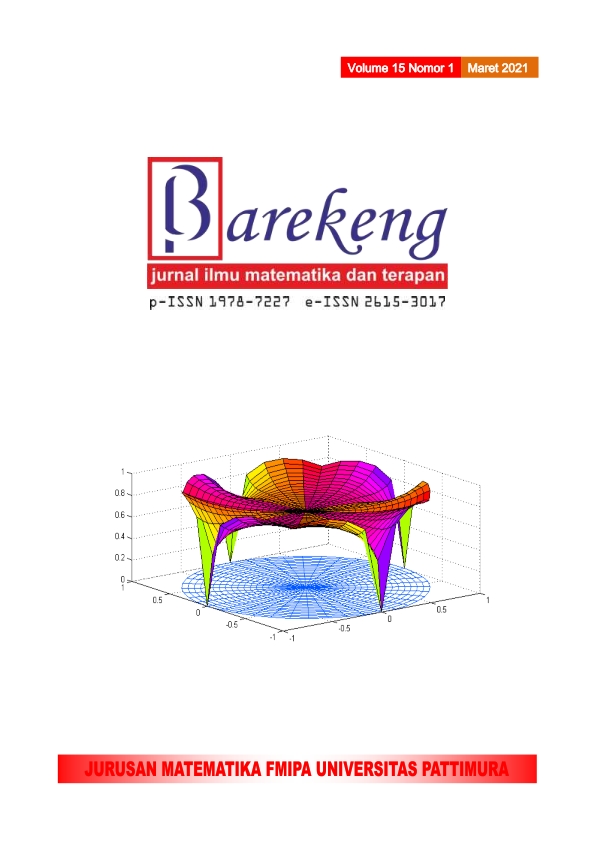APLIKASI MODEL RANTAI MARKOV UNTUK MENGANALISIS TINGKAT KENYAMANAN DI KOTA MAJENE BERDASARKAN TEMPERATURE HUMIDITY INDEX (THI)
Abstract
This study applied the Markov chain model on the daily temperature and relative humidity data that was collected from the Meteorology and Geophysics Agency station in Majene district for the period 1983 to 2011. This study aims to analyze the comfortable level category in the Majene city based on the Temperature Humidity Index by calculating the probability of steady-state, the mean residence time and the mean first passage time. Categorizing the level of comfortable which is based on the Temperature Humidity Index consists of three categories, namely the comfortable, quite comfortable and uncomfortable. The trend of comfortable levels in the Majene city from 1983 to 2011 was fluctuated in the categories of quite comfortable and uncomfortable. Uncomfortable category occurs in October and November each year. The steady-state probability values indicates that the quite comfortable category has the highest chance of appearance, which is around 70%, and the comfortable category has the smallest chance of appearance, which is only about 5%. Meanwhile, the mean residence time and the mean first passage time indicate that the quite comfortable category have the longest duration of occurrence, which is around 5 days, and has the shortest duration to recur after occurring in the previous event, which is around 1.43 days.
Downloads
References
Hasan, H., Che Nordin, M. A., Mohd Salleh, N. H. “Modelling Daily Maximum Temperature for Thermal Comfort in Northern Malaysiaâ€. Adv. Environ. Biol., 9(26), 12-18, 2015
Semenov, M. A. and Barrow, E.M, “Use of a stochastic weather generator in the development of climate change scenarios†Climatic Change, 35(4): 397-414, 1997.
Keith, D. A., et. al.†Predicting extinction risks under climate change: coupling stochastic population models with dynamic bioclimatic habitat models†Biology Letters, 4(5): 560–563, 2008.
Wilks, D., “Adapting stochastic weather generation algorithms for climate change studies†Climatic Change, 22: 67-84, 1992.
Chulsang, Y, Jinwook, L, Yonghun, R, “Markov Chain Decomposition of Monthly Rainfall into Daily Rainfall: Evolution of Climate Change Impactâ€, Advances in Meteorology, vol. 2016, 2016.
Mieruch, S, et. al, “Markov chain analysis of regional climatesâ€, Nonlinear Processes in Geophysics, vol. 17, 651–661, 2010.
Florescu, I.I. and Levin, F. “Estimation procedure for a hidden Markov chain model with applications to finance, climate data and earthquake analysisâ€. 2008, Retrieved June 28, 2020, from http://www.math.ubordeaux1.fr/~pdelmora/hmm-finance.pdf
Wati, T dan Fatkhuroyan. “Analisis Tingkat Kenyamanan di DKI Jakarta Berdasarkan Indeks THI (Temperature Humidity Index), â€Jurnal Ilmu Lingkungan†15(1), 57- 63, 2017.
Matzarakis, A., H. Mayer and M.G. Iziomon, “Applications of a universal thermal index: physiological equivalent temperature†International Journal of Biometeorology, 43(2): 76-84, 1999.
American National Standard Institute (ANSI), ASHRAE Standard, 2013.
Thom, E. C, The discomfort index, Weatherwise 12(2), 57–60, 1959
Effendy S, Bey, A, Zain, A.F.M, Santosa, I, “Peranan ruang terbuka hijau dalam mengendalikan suhu udara dan urban heat island wilayah JABOTABEKâ€, J Agrom Indonesia. 20(1):23-33, 2006.
W. Sanusi, A. A. Jemain, W. Z. W. Zin, M. Zahari, â€The Drought Characteristics using the First-Order Homogeneous Markov Chain of Monthly Rainfall Data in Peninsular Malaysiaâ€, Water Resource Management, Vol. 29: 1523 – 1539, 2015.
Ross, S. M., Introduction to Probability Models, 9th ed, Academic Press, California, 2007
Nieuwolt, S, Tropical Climatology. London: Wiley; 1977.
Badan Pusat Statistik, Majene Dalam Angka 2018, Majene: BPS Kabupaten Majene, 2018.
Authors who publish with this Journal agree to the following terms:
- Author retain copyright and grant the journal right of first publication with the work simultaneously licensed under a creative commons attribution license that allow others to share the work within an acknowledgement of the work’s authorship and initial publication of this journal.
- Authors are able to enter into separate, additional contractual arrangement for the non-exclusive distribution of the journal’s published version of the work (e.g. acknowledgement of its initial publication in this journal).
- Authors are permitted and encouraged to post their work online (e.g. in institutional repositories or on their websites) prior to and during the submission process, as it can lead to productive exchanges, as well as earlier and greater citation of published works.






1.gif)



